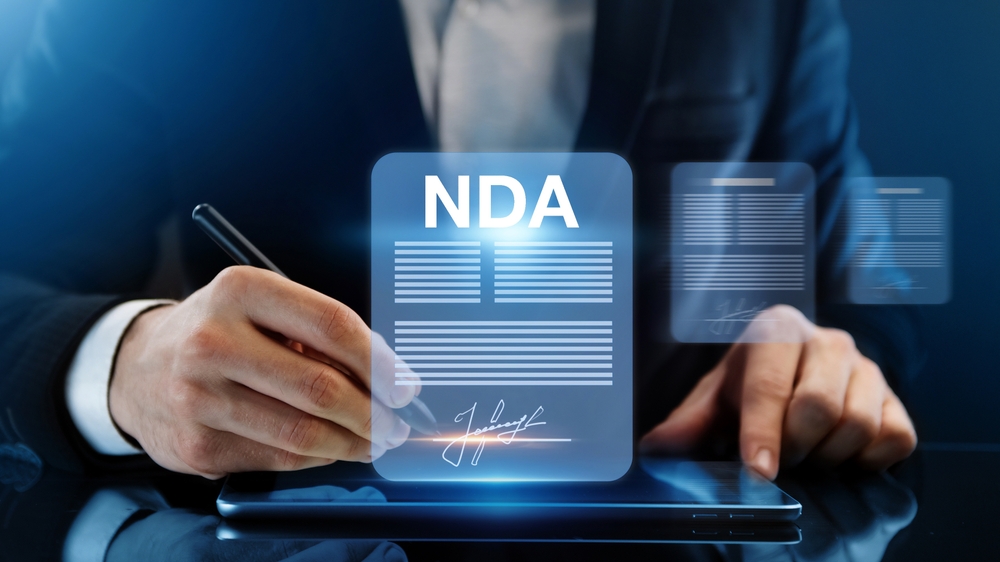In every modern organisation, custom code has become both crown-jewel intellectual property and the beating heart of day-to-day operations. Engaging an external software development company to create, migrate or maintain that code inevitably requires opening the door to critical business information—source repositories, algorithms, market analyses, customer datasets and strategic road-maps. NDAs are often signed at the outset of a business deal to protect sensitive information exchanged between businesses during negotiations or collaborations. If a competitor or an unrelated third party were to gain access to such information, the financial and reputational repercussions could be devastating. This is why a thoughtfully drafted non-disclosure agreement—commonly shortened to NDA (NDA stands for non-disclosure agreement)—is a non-negotiable first step in almost every serious software development project.
What is an NDA?
A Non-Disclosure Agreement (NDA) is a foundational document in the software development industry, designed to safeguard confidential information exchanged during a business relationship. In software development, NDAs are essential for protecting critical business information, such as intellectual property, trade secrets, and other sensitive information that could impact a company’s competitive position. By clearly outlining the terms under which such information can be shared and used, a non disclosure agreement helps ensure that proprietary knowledge remains secure. Signing an NDA not only protects the interests of all parties involved but also builds trust, setting the stage for a productive and secure collaboration throughout the software development process. Whether you are developing a new application, sharing business plans, or discussing a custom software solution, having a well-drafted NDA in place is a key step in protecting your business and its valuable assets.
Benefits of an NDA in Software Development
- Protects competitive edge – safeguarding new features, unique algorithms or monetisation strategies until launch prevents rivals from replicating them prematurely.
- Clarifies ownership of intellectual property – spelling out that all code, documentation and derivative works remain the exclusive property of the owner company eliminates ambiguity later in the relationship.
- Instils trust and accelerates collaboration – signing an NDA early signals professionalism and encourages frank discussion of requirements, budgets, risks and constraints. An NDA restricts the ability to share confidential information outside the agreed scope, ensuring sensitive data is only used for its intended purpose.
- Reduces the risk of financial damages – by setting liquidated damages or other remedies upfront, an NDA puts a price on breaches, deterring careless handling of data. The NDA imposes a legal obligation on all parties to keep information confidential.
- Acts as foundation for further contracts – once confidentiality boundaries are clear, parties can negotiate development, licensing or support agreements on the same page. NDAs are especially important when parties need to share confidential information during the course of a project.
Parties Involved and Their Obligations
In any software development NDA, understanding the roles and responsibilities of the parties involved is crucial. Typically, there are two main parties: the Disclosing Party, who owns or controls the confidential information, and the Receiving Party, often the software development company or service provider, who gains access to this sensitive information for the purpose of the project. The Disclosing Party is responsible for clearly identifying what information is confidential, while the Receiving Party must take all necessary steps to maintain confidentiality, prevent unauthorized disclosure, and use the information solely for the agreed-upon software development project. Additionally, the Receiving Party may be required to return or securely destroy all confidential materials at the end of the engagement or upon request. Both parties must adhere to the obligations set out in the software development NDA to ensure that sensitive information remains protected throughout the development lifecycle and beyond.
Types of NDAs in Software Development
When it comes to software development, choosing the right type of NDA is essential for effective protection of confidential information. There are three primary types of non disclosure agreements commonly used in the industry. A Unilateral NDA, or one way NDA, is used when only one party—typically the owner company—shares sensitive information, and the receiving party agrees to keep it confidential. A Bilateral NDA, also known as a mutual NDA, is appropriate when both parties anticipate sharing confidential information with each other and want mutual protection. For projects involving multiple parties, such as joint ventures or collaborations with several vendors, a Multilateral NDA streamlines the process by having all parties agree to protect shared information within a single agreement. The choice between unilateral, bilateral, or multilateral NDAs depends on the nature of the software project and the flow of confidential information between the parties involved.
When Should You Sign an NDA for Software Development?
- Before sharing project briefs or RFPs – high-level concept documents often reveal future product positioning, market gaps and pricing models.
- During early workshops or discovery sprints – user pain-points, internal process maps, legacy architecture diagrams and critical integration endpoints surface in these sessions.
- When providing sandbox or test-environment access – even synthetic datasets can contain schema designs that hint at customer behaviour or reveal proprietary analytics logic.
- Prior to code walkthroughs, security audits or architecture reviews – these deep dives expose source code, cryptographic keys, internal APIs and vulnerability reports.
- While evaluating third-party add-ons or integration partners – the other party may need to see non-public SDKs, road-maps and licence metrics.
Each new project typically requires its own NDA and may be accompanied by other software development contracts such as MSAs or SOWs to ensure comprehensive legal protection.
Key Clauses Every Software Development NDA Should Include
NDA agreements are essential in software development projects to protect sensitive information, and should be tailored to the specific needs of each project.
| Clause | Why It Matters in Software Projects | Questions to Ask |
|---|---|---|
| Definition of confidential information | Must explicitly cover source code, build scripts, infrastructure diagrams, user data and test plans. | Does the wording capture both tangible and intangible forms of information? |
| Purpose limitation | Allows use of information solely for scoping, developing or testing the identified software projects. | Can the recipient reuse models or know-how for other clients? |
| Exclusions | Public knowledge and independently developed materials are excluded to prevent over-reach. | Is reverse engineering prohibited even if the output is public? |
| Term and survival | Development cycles can last months; support contracts can last years. | Does confidentiality survive at least three to five years after project completion? |
| Return or destruction of materials | At project end, confidential data should be deleted or returned. | Does the clause cover off-site backups and cloud copies? |
| Governing law and jurisdiction | A clear venue speeds up enforcement. | Is the chosen law practical if parties operate in different countries? |
| Remedies for breach | Injunctive relief, indemnities and financial penalties deter leaks. | Are liquidated damages reasonable rather than punitive? |
| Subcontractor obligations | Many providers engage freelancers or external DevOps teams. | Must all subcontractors sign an equivalent NDA? |
| Obligations | The clause should clearly outline the parties obligations, including the responsibilities of the recipient party to protect confidential information, restrict its use, and follow security measures. | Are all parties, including the recipient party, aware of their specific obligations under the NDA? |
| Residual knowledge carve-out | Developers naturally retain general skills and ideas. | Does the carve-out respect your trade secrets? |
NDAs, MSAs, and SOWs are designed for different purposes but work together to provide comprehensive legal protection in software development projects.
Confidentiality and Proprietary Information
Confidentiality and the protection of proprietary information are at the heart of any software development NDA. The agreement should provide a clear definition of what constitutes confidential information, including source code, trade secrets, sensitive data, and any other information considered confidential by the disclosing party. It is essential that the NDA outlines the receiving party’s obligations to safeguard this information, such as restricting access to authorized personnel, implementing robust security measures, and preventing unauthorized use or disclosure. By explicitly defining and protecting proprietary information, the NDA helps maintain a company’s competitive edge and reduces the risk of financial damages resulting from leaks or misuse. Ensuring that all parties understand and comply with these confidentiality obligations is critical to the success and security of any software development project.
How an NDA Fits into the Software Development Process
- Requirement Gathering & Solution Design
Once the NDA is signed, stakeholders can openly discuss pain points, budget constraints and regulatory considerations. This transparency results in a more realistic project scope and prevents nasty surprises during later sprints. - Architecture & Prototyping
Architects often produce high-level component diagrams that reveal internal project structure and future scaling plans. Confidentiality obligations keep these blueprints out of competitors’ hands. - Coding & Testing
Engineers require access to version-control systems, continuous-integration pipelines, staging servers and sometimes production data. The NDA should handle how such information is stored, who can access it and under what conditions sharing is prohibited. - Deployment & Maintenance
Post-launch, hot-fixes and feature updates might involve fresh secrets—API tokens, encryption keys, customer usage metrics. The NDA continues to apply long after the initial release, ensuring sensitive information remains protected throughout the product lifecycle. - Knowledge Transfer & Handover
When internal teams assume control of the codebase, repositories and documentation must be transferred securely. The agreement should require the service provider to confirm deletion of all local copies within an agreed timeframe.
To streamline this process and ensure all key clauses are included, consider using NDA templates specifically tailored for software development. These customizable NDA templates save time and help maintain legal effectiveness when protecting sensitive information.
Governing Law and Jurisdiction in Software Development NDAs
Specifying the governing law and jurisdiction in a software development NDA is a vital step in ensuring the agreement’s enforceability. The governing law determines which country’s or region’s legal framework will apply to the interpretation and enforcement of the NDA, while the jurisdiction clause identifies where any legal disputes will be resolved. By clearly stating these elements, both parties understand their rights and obligations under the agreement, and can avoid confusion or conflict if a breach occurs. This clarity is especially important in cross-border software development projects, where parties may be located in different countries. Including a well-defined governing law and jurisdiction clause in your software development NDA helps protect your interests, streamlines dispute resolution, and provides a solid legal foundation for your business relationship.
Common Pitfalls and How to Avoid Them
- Over-broad definitions – calling every single message or meeting confidential can render the agreement unenforceable. Tailor the scope to genuinely sensitive information. Protecting the specific trade secrets and proprietary information that help your business stand out—your business stand—is more effective than labeling all information as confidential.
- Missing subcontractor flow-down – if contractors are brought in without equivalent NDAs, the protection chain breaks. Ensure downstream parties sign and comply.
- No audit or certification right – without the right to request proof of deletion or security posture, you rely largely on goodwill. Include reasonable verification rights.
- Jurisdiction mismatch – picking a foreign governing law may look neutral but can complicate enforcement. Choose a venue familiar to both sides or include arbitration options.
- Inadequate remedies – “irreparable harm” language alone rarely recovers costs. Consider a balanced schedule of financial damages tied to breach severity.
Practical Steps to Drafting and Negotiating Your NDA
- Use a dedicated template
Start with a reputable software development NDA template rather than a generic business form. Templates tailor language for code ownership, residual knowledge and open-source exclusions. - Keep the document under five pages
Excessive length delays signing and invites loopholes. Aim for clear definitions, concise obligations and straightforward enforcement. - Align with project milestones
Reference specific deliverables—design documents, sprints, release candidates—so obligations map naturally onto the software development process. - Specify security controls
Stating that the receiving party must follow ISO 27001 or SOC 2 controls can prevent accidental leaks. - Plan for data protection compliance
If personal data is shared, pair the NDA with a data-processing agreement to satisfy GDPR or other regulations. - Set a reasonable term
Most trade secrets lose value after five to seven years. Extremely long terms may be challenged in court. - Negotiate residual knowledge fairly
Developers need freedom to use general techniques learned on the job. Balance this with explicit bans on copying source code or proprietary libraries.
Working With Dedicated Teams Under NDA
Outsourcing an entire feature backlog to dedicated software developers is increasingly popular because it speeds delivery while controlling costs. When team members sit outside your organisation, however, the risk of inadvertent disclosure rises. A robust NDA should therefore:
- Name each individual developer or require the vendor to keep a list of authorised personnel.
- Oblige the vendor to brief new hires on confidentiality obligations before granting repository access.
- Include immediate removal of access upon termination or role change.
- Require secure communication channels (e.g., encrypted repository links, MFA-protected project-management tools).
NDA Considerations for Custom Software Development Outsourcing
Global teams can accelerate development, but they also introduce cross-border legal issues. When you engage custom software development outsourcing through an overseas vendor, pay special attention to:
- Conflict of laws – select governing law in a jurisdiction likely to enforce UK judgments.
- Data-transfer mechanisms – if data leaves the UK, insert standard contractual clauses or an international data transfer addendum.
- Export-control compliance – certain encryption libraries or AI models may be subject to export licences. The NDA should place the burden of compliance on the recipient.
- Cultural factors – clarify what constitutes confidential behaviour (e.g., no screenshots of dashboards for personal portfolios).
For more on best practices in outsourcing arrangements, see custom software development outsourcing.
Sample Outline for a Software Development NDA
- Parties – legal names and registered addresses.
- Definitions – detailed but precise list of what is considered confidential information.
- Purpose – limited to evaluating, building or supporting the specified software.
- Obligations – care level, authorised personnel, subcontractor requirements.
- Exclusions – public knowledge, independent creation, compulsory disclosures.
- Term – duration of obligations (e.g., five years after last disclosure).
- Return & destruction – secure deletion of code, backups and logs.
- Remedies – equitable relief, limitation of liability, indemnities.
- Governing law & dispute resolution – courts of England and Wales or agreed arbitration.
- Signatures – duly authorised representatives of each party.
Tips for Enforcing an NDA
- Mark documents clearly – labelling files “CONFIDENTIAL” strengthens your position.
- Keep disclosure records – note when and to whom each repository or document was shared.
- Monitor access logs – version-control analytics can reveal unusual clone or download activity.
- Act quickly on rumours – delays may be interpreted as waiver of rights.
- Seek injunctive relief before damages – stopping the leak is often more valuable than compensation.
Conclusion
A well-crafted NDA for software development does far more than add legal jargon to the paper trail. It underpins trust, fosters open technical dialogue and safeguards the substantial investment that goes into building software. By tailoring definitions, obligations and remedies to the unique rhythms of the software development process—and by signing at the right stage—you can collaborate confidently with vendors, freelancers and internal teams alike. Pair the agreement with clear security controls, diligent access management and periodic audits, and you will create a robust barrier against leaks while enabling the innovation your organisation needs to stay ahead.
When you next engage outside talent to transform a visionary concept into a revenue-generating application, make the NDA your first sprint—and you will thank yourself on launch day.
NDA For Software Development FAQs
Q: Do NDAs restrict open-source contributions made during a project?
A: They can, unless expressly carved out. If your project relies on open-source frameworks, specify that contributions to public repositories, excluding confidential forks, are permissible.
Q: Is a mutual NDA always better than a unilateral one?
A: Use a mutual NDA when both parties intend to exchange sensitive data. If only one side is sharing crucial information, a unilateral NDA reduces paperwork and potential liabilities.
Q: Can an NDA alone protect my business ideas?
A: An NDA is a deterrent and legal remedy, but you should combine it with strong access controls, secure coding practices, code reviews and vigilant vendor management.
Q: What happens if a developer accidentally leaks code?
A: Most NDAs treat accidental disclosure as a breach, triggering notification obligations and potential damages. Prompt remediation and cooperative action may mitigate liability, but the contract wording is crucial.
Q: Should investors sign an NDA before seeing my pitch deck?
A: Many institutional investors refuse generic NDAs. Instead, share a redacted deck first, then request an NDA once discussions turn to unreleased product details or proprietary algorithms.
















